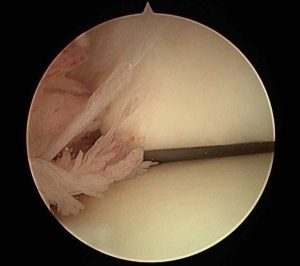Key-Hole Surgery
Written by Dr Mike Smith
What Conditions can we treat with this Key Hole technique?
- Ankle Instability
- Ankle Impingement
- Removal of loose bodies within the ankle joint
- Ankle cartilage damage
- Ankle arthritis / Fusion

What are the benefits of ‘Key Hole’ Surgery
There are many benefits to performing surgical procedures via keyhole techniques. These may include:
Minimal Scars
Rapid Rehabilitation
Minimal Soft Tissue Dissection
Early Recovery
Minimal Bleeding
Early Discharge Home
Anterior Ankle Arthroscopy:
This is the more common form of ankle arthroscopy and is used to address the majority of conditions affecting the ankle joint.
The procedure involves making two tiny (4-5mm) incisions at the front of the ankle. One ‘portal’ is used to introduce the arthroscopic camera, and the other ‘portal’ is for the passage of tiny specialised instruments. Once the condition has been address, the portals are closed and a bandage is applied. Depending on what condition was addressed, you can frequently commence walking the same day.


Posterior Ankle Arthroscopy:
This procedure is typically reserved for patients with posterior ankle impingement. The lead up to the surgery, and instructions following the surgery are similar to what is outlined above in ‘Anterior Ankle Arthroscopy’. The two incisions that are used are both made at the back (posterior) aspect of the ankle joint alongside the achilles tendon (Heel cord).

Following discharge, and depending on which specific condition was addressed, you will be informed of whether you will require a supportive shoe/boot for a period of time. You will be seen in the rooms 2 weeks following the procedure and your bandage removed.
A dedicated physiotherapy program is often encouraged to help maximise your return to function in the coming weeks.
Ask the Surgeon
Visit us on Facebook to "Ask the Surgeon"
Want to ask us a question? Visit us on Facebook and post your question. Your questions will be public, and answered as soon as possible.
Contact Us
Tel: (08) 7099 0188
Address: 94-96 Fullarton Rd, Norwood, 5067
Orthopaedics 360
Orthopaedics 360
P: (08) 7099 0188
F: (08) 7099 0171
Southern Specialist Centre
Orthopaedics 360
P: (08) 7099 0188
F: (08) 7099 0171
Health @ Hindmarsh
Orthopaedics 360
P: (08) 7099 0188
F: (08) 7099 0171
